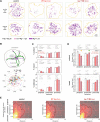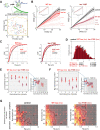Tau differentially regulates the transport of early endosomes and lysosomes
- PMID: 36129768
- PMCID: PMC9634973
- DOI: 10.1091/mbc.E22-01-0018
Tau differentially regulates the transport of early endosomes and lysosomes
Abstract
Microtubule-associated proteins (MAPs) modulate the motility of kinesin and dynein along microtubules to control the transport of vesicles and organelles. The neuronal MAP tau inhibits kinesin-dependent transport. Phosphorylation of tau at Tyr-18 by fyn kinase results in weakened inhibition of kinesin-1. We examined the motility of early endosomes and lysosomes in cells expressing wild-type (WT) tau and phosphomimetic Y18E tau. We quantified the effects on motility as a function of the tau expression level. Lysosome motility is strongly inhibited by tau. Y18E tau preferentially inhibits lysosomes in the cell periphery, while centrally located lysosomes are less affected. Early endosomes are more sensitive to tau than lysosomes and are inhibited by both WT and Y18E tau. Our results show that different cargoes have disparate responses to tau, likely governed by the types of kinesin motors driving their transport. In support of this model, kinesin-1 and -3 are strongly inhibited by tau while kinesin-2 and dynein are less affected. In contrast to kinesin-1, we find that kinesin-3 is strongly inhibited by phosphorylated tau.
Figures







References
-
- Balabanian L, Chaudhary AR, Hendricks AG (2018). Traffic control inside the cell: microtubule-based regulation of cargo transport. Biochem 40, 14–17.
-
- Ballatore C, Lee VM, Trojanowski JQ (2007). Tau-mediated neurodegeneration in Alzheimer’s disease and related disorders. Nat Rev Neurosci 8, 663–672. - PubMed
-
- Beaudet D, Berger CL, Hendricks AG (2022). Tau inhibits the long-range, dynein-mediated motility of early phagosomes. bioRxiv, 495679.
Publication types
MeSH terms
Substances
Grants and funding
LinkOut - more resources
Full Text Sources
Miscellaneous

